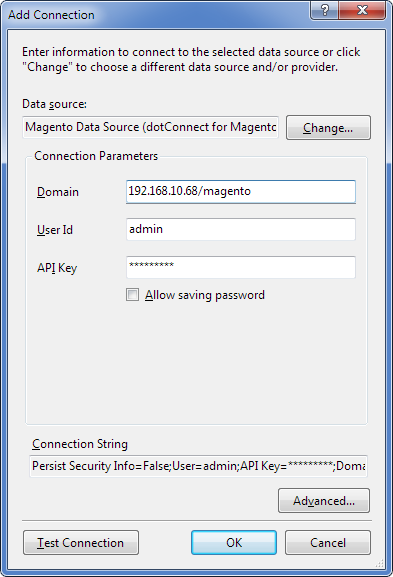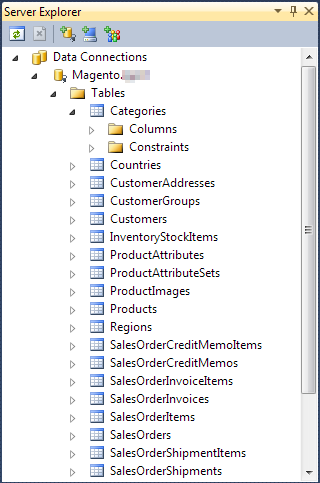This tutorial describes how to connect to Adobe Commerce.
In this walkthrough:
- Requirements
- General information
- Creating MagentoConnection
- Opening connection
- Closing connection
- Modifying connection
Requirements
In order to connect to Adobe Commerce you need to have the corresponding account, dotConnect for Adobe Commerce installed and IDE running. You also have to know the required connection parameters described below.
Note that if you do not use design-time (specifically, if you do not place designer MagentoConnection component from the Toolbox to the form), you have to embed licensing information manually. This is described in topic Licensing.
Required Connection Parameters
To establish a connection to server you have to provide the required connection parameters to dotConnect for Adobe Commerce. This information is used by MagentoConnection component to connect to Adobe Commerce. The parameters are represented as a connection string. You can compose the connection string manually or have dotConnect for Adobe Commerce construct it for you.
The following connection string parameters are required:
Creating a Connection to Adobe Commerce
Design time creation
The following assumes that you have IDE running, and you are currently focused on a form designer.
- Open Toolbox and find MagentoConnection component in dotConnect for Adobe Commerce category.
- Double-click the component. Notice that new object appears on the designer underneath the form. If this is first time you create the MagentoConnection in this application it is named adobe commerceConnection1.
- Click on the adobe commerceConnection1 object and press F4 to focus on object's properties.
- Enter the required connection string parameters, described above, to the corresponding boxes.
- Notice that as you assign values to these properties the ConnectionString property is automatically updated to reflect your settings. Now it contains something like "domain=192.168.10.68/magento;user=Test;apikey=testpassword;".
- If necessary, click the Advanced button and configure other connection string parameters. You can find the description of these connection string parameters in the MagentoConnection.ConnectionString topic.
Run time creation
You can also configure a connection at run-time by setting its ConnectionString property (note that you have to add references to Devart.Data.Magento.dll, Devart.Data.SqlShim.dll, and Devart.Data.dll assemblies):
Using connection string builder
If you decide to setup connection by assigning values to several properties, consider using MagentoConnectionStringBuilder class. It has all of the possible connection settings exposed as properties, thus allowing to customize the connection at full extent.
Notice that in this example we used MagentoConnection constructor that accepts connection string as argument.
For the information on arguments allowed in the connection string, refer to the description of the MagentoConnection.ConnectionString property.
Creating Connection in Server Explorer
To create a Server Explorer connection, you just need to:
- Click Connect to Database on the Server Explorer toolbar
- If the Adobe Commerce Data Source is not selected by default, click the Change button.
- Select Adobe Commerce Data Source (dotConnect for Adobe Commerce) and click OK.

After this you can browse Adobe Commerce objects in Server Explorer.

Opening connection
Opening a connection is as simple as that:
Of course, the myConnection1 object must have a valid connection string assigned earlier. When you call Open, dotConnect for Adobe Commerce tries to find the host and connect to Adobe Commerce. If any problem occurs it raises an exception with brief explanation on what is wrong. If no problem is encountered dotConnect for Adobe Commerce tries to establish the connection during ConnectionTimeout interval. Finally, when connection is established, the Open method returns and State property is changed to Open.
In design time you can connect to server in few steps:
- Right-click on the connection object in designer and then click Connect.
- In the dialog window provide the required connection parameters.
- Click on the connection object and press F4 to focus on object's properties.
- If necessary, click the Advanced button and configure other connection string parameters. You can find the description of these connection string parameters in the MagentoConnection.ConnectionString topic.
- Click Connect to establish connection.
Or you can simply change the State property to Open in the Properties window to establish a connection using the current connection string.
Closing connection
To close a connection call its Close method, or set its State property to Closed.
The following example summarizes aforementioned information and shows how to create, setup, open, use and then close the connection.
The sample code connects to server, shows its version and then closes the connection. This actually is a rare usage, because in real applications connections are used by other objects like MagentoCommand, MagentoDataReader and others. For more information on this please see corresponding tutorials or reference information.
Modifying Connection
You can modify connection by changing properties of MagentoConnection object. Keep in mind that while some of the properties can be altered freely, most of them close connection when new value is assigned.